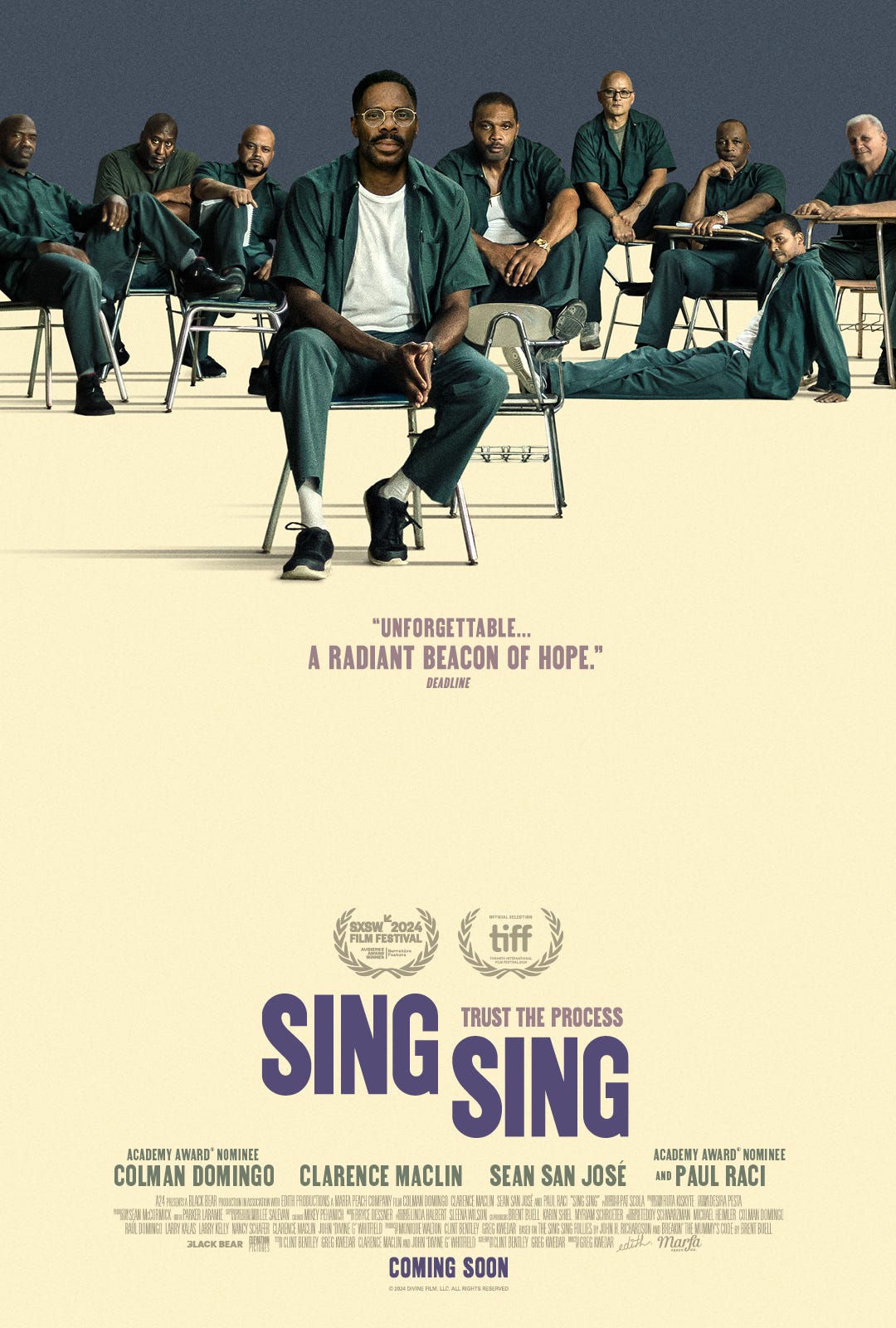Blink Twice is a psychological thriller about the abuse of power.
Don’t agree? Too bad. That’s not my opinion…it's fact. It’s on the packaging. Before Zoe Kravitz’ directorial debut even begins, audiences are greeted with the following trigger warning:
Trigger warnings such as this one have become increasingly common in recent years, with television shows such as Better Call Saul or Baby Reindeer contextualizing certain episodes before they have even begun. They seem less common at the cinema, however. Like Baby Reindeer before it, Blink Twice does feature quite a disturbing depiction of sexual violence, the one form of violence I generally struggle to see the value in representing onscreen. Of course, filmmakers are within their right to include just about any imagery they would like in their work, so long as they justify those kinds of provocations. I found Blink Twice shallow and incoherent, and so I found its rape sequence particularly jarring and foul, but I do empathize with those who were indeed triggered by the material. No matter the value of the content itself, I remain concerned with the warning’s embarrassing attempts to contextualize and explain the role of sexual violence in Blink Twice, all before we have seen a single frame of the film!
Trigger warnings are likely to become more common, and the MPA would be wise to regulate them accordingly. After all, a film’s MPA rating is already meant to serve as a kind of warning to parents and individuals who want to make informed decisions about the kinds of movies they watch. Blink Twice is an R-rated film, the MPA citing “strong violent content, sexual assault, drug use and language throughout, and some sexual references.” Why is a film’s rating not displayed before it begins? Wouldn’t that exact rating and description serve as a sufficient trigger warning for Blink Twice? If concern still lingered about an audience’s awareness of particularly triggering content, the MPA could still incorporate an additional warning for those films that required it. The need for a trigger warning could be mandated by the MPA, but a studio/filmmaker could also opt to work with the MPA in implementing certain language if they deemed it necessary for a given project.
And yes…I proffer this haphazard vision of our cinematic future out of concern over one measly sentence in that Blink Twice trigger warning: Blink Twice is a psychological thriller about the abuse of power.
And yes…Blink Twice is a psychological thriller about the abuse of power, just like Get Out and Don’t Worry, Darling and countless other movies before it.
Indeed, a psychological thriller about the abuse of power is not a very original concept in 2024. I would argue almost all films are about power in one way or another, and only a film that is aware (and ashamed) of its paper-thin excavation of the topic would kick things off with an overt expression of its genre and theme. Blink Twice runs its trigger warning before even the studio bumpers have signaled the start of the film. Only Nicole Kidman and the previews predate the message. Will the warning be included before the digital/streaming versions of the film? What about the physical release? Are we entitled to view the trigger warning as a part of Kravitz’ debut film much like any other frame? Even as we make necessary concessions in service of developing a safer and more welcoming cinematic landscape, the question persists as to whether or not artists retain the right to contextualize their work. A content warning should not serve as a justification of the content, but rather a simple heads-up that the content exists. The contextualization of any sensitive content can be carried out by audiences and critics — even the artists themselves — but only after the art has been received.
Variety reported two days before the film’s release that Amazon MGM was responsible for issuing the trigger warning, so perhaps it is unfair to lay its lazy language at the feet of Blink Twice and its first-time filmmaker. To be fair, Kravitz does make good on the “psychological thriller” portion of the opening apology warning. The film is effectively twisty and tense, even if most of those twists prove increasingly unnecessary. The cast is also excellent across the board, nailing joke after joke, even as the satirical tone of the film proves increasingly incompatible with those horrific stretches of violence against women. Indeed, Kravitz is unprepared for the conversations around class, gender, and race with which her film only flirts, settling for a superficial treatise on a nonspecific notion of “power.”
And yet, in most cases, it would be sufficient to describe a film like Blink Twice as uneven albeit intriguing, much like most other directorial debuts. But the project’s cowardice in the face of those potential shortcomings underscores several of the most alarming developments in the entertainment industry today.
If “power” feels like our culture’s latest ambiguous obsession, then “trauma” may be a close second. The increasing presence of trigger/content warnings is understandably part of an attempt to account for that ever-widening array of traumas we continue to discover within ourselves and each other. As a traumatized man myself — no one is safe from the horrors of a Jewish upbringing — I can appreciate any cultural shift towards warmth and safety. But I also, perhaps controversially, believe in art’s right to traumatize or provoke. It would be dramatic to regard any content warning as a proper spoiler, but a preface such as the one contextualizing the events of Blink Twice does threaten to neuter an artist’s intentions. Worse, it strips the viewer of their agency in the meaning-making process. A trigger warning may be an act of compassion, but it just as easily could function as one of condescension. Kravitz’ agenda with Blink Twice is unclear, so the warning’s supercilious stench smells shockingly sage in hindsight. Still, a better film could be fully undermined by an introduction that admits to a certain distrust in its audience.
This is what you are about to watch, and this is why you are going to watch it.
This is how you are going to feel while watching it, and this is why we want you to feel that way.
We already bought our tickets. We might appreciate a brief reminder of what we are getting ourselves into, but we are otherwise prepared to experience the film in its totality. In an era where media literacy may already be at an all-time low, we should all be alarmed by these attempts to revoke our right to participate in the interpretive process altogether.
Of course, we are well aware of film’s dual status as both art and commerce. The studio’s implementation of the content warning before Blink Twice is indicative of commercial rather than artistic concerns. Commerciality will never fully gel with the promotion of free thought or media literacy, but that is a sad reality to accept.
After all, it is the same reality that has made space for AI in our rapidly evolving entertainment landscape. The emergence of AI in storytelling suggests that stakeholders are not only disinterested in the kind of “active viewing” that makes media consumption so stimulating and rewarding, but also that they regard creativity with similar flippancy and contempt.
The relationship between any two humans — let alone artist and consumer — is a powerful one in that there exist multiple layers of meaning. If I write you a text, there is a superficial interpretation of that message:
Hey, what’s up with you?
I am asking you how you are doing.
Not much, just exhausted. U?
You are tired, and you are asking me the same question in return. These superficial interpretations are sufficient in most cases, but what makes human interaction and creativity so exciting is the supra-ficial interpretation they invite.
I could have chosen to ask that question without a question mark, for example. I could have used an entirely different set of words entirely! You could have spelled out “you” but you chose to type out a single letter “u” instead. We all make these kinds of snap decisions on a regular basis, and artists (at least the good ones) make them with particular consideration and attention to detail. ChatGPT has admittedly reached a level of competence wherein superficial meaning is easy to come by, but it will inherently never be able to offer any meaning beyond that, as its output is determined only by ones and zeroes.
Blink Twice is superficially intriguing based on its premise alone, but the opportunity to consider the intentions of Kravitz and her entire cast is what makes engaging with the film such a thrill, no matter my final thoughts on its quality or value. I have written in the past about the value of both positive and negative criticism. We remain indebted to films like Blink Twice for sharpening our critical faculties and spurring conversations such as this one. I do not resent Kravitz’ muddled concoction, but rather Amazon MGM’s unwillingness to allow that mess to speak for itself. This is the same studio, after all, that may or may not have used AI to put the finishing touches on Doug Liman’s maligned Road House remake earlier this year. With such blatant disregard for creators and audiences alike, it is fair to wonder what independence is left for any of us in our entertainment ecosystem.
Do not ask questions. Do not challenge. Do not provoke.
So long as we buy our tickets, pay our monthly subscription fees, and get angry (but not too angry) online, we are sufficient partners in an otherwise perfunctory relationship. Perhaps the vague exploration of “power” in Blink Twice is by design.
Maybe there exists only a single layer after all.
Letterboxd Review of the Month
Much like Frances McDormand in Nomadland, Colman Domingo threatens to undermine an otherwise overwhelmingly authentic film just through his sheer presence alone. Like McDormand, Domingo turns in a beautiful performance, and a very actorly one at that. Sing Sing is just stagey and sentimental enough to justify such a big and expressive performance at its core, but Clarence Maclin and the rest of the nonprofessional cast clearly steal the show, and any time spent away from them is an unfortunate reminder of the artifice at play here.
The highlight of the film for me is a scene completely divorced from that artifice, when a former prisoner visits the RTA members to describe life on the outside. The scene feels improvised, freed from the shackles of Sing Sing's occasionally didactic script. In their own stripped-down way, raw moments like this one make Sing Sing feel fresh, maybe even vital. But too many other scenes play out alongside a mawkish score, or work to resolve the threads of a plot that fails to truly differentiate itself.
Of course, the film is too moving and sincere to dislike, and Domingo still deserves all the accolades for his moving performance. It's just a shame he gives it in a film that may have been better off without it.
Follow me on Letterboxd at @creid61, and keep up with the rest of my work on Instagram at @coryreid6125.
You can also support my work over at Buy Me a Coffee.








